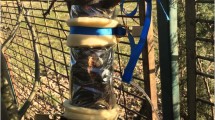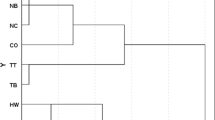Abstract
The emissions of spruce grafts (Picea abies), caused by infestation of an acarid species of the genus Nalepella were investigated. Volatiles of three clones, both healthy and infested, with different susceptibility to the large pine weevil Hylobius abietis were collected by solid phase micro extraction (SPME) and analyzed by gas chromatograph coupled to mass-spectrometry (GC-MS). In addition, enantiomers of the main chiral compounds were separated by a two dimensional-gas chromatograph (2D-GC). In the characteristic flower-like fragrances emitted by the infested grafts large amounts of E-β-farnesene, E,E-α-farnesene, (−)-linalool, methyl salicylate and minute amounts of benzyl alcohol, E-anethole, methyl benzoate, neral and geranial were found. All together, these compounds could explain the characteristic scent emitted by the infested seedlings. Large differences in the emissions of E-β-farnesene, E,E-α-farnesene and methyl salicylate were found between but not within the clones.






Similar content being viewed by others
References
Arimura G-I, Huber DP, Bohlmann J (2004a) Forest tent caterpillars (Malacosoma disstria) induce local and systemic diurnal emissions of terpenoid volatiles in hybrid poplar (Populus trichocarpa × deltoides): cDNA cloning, functional characterization, and patterns of gene expression of (−)-germacrene d synthase, PtdTPS1. Plant J 37(4):603–616
Arimura G-I, Ozawa R, Kugimiya S, Takabayashi J, Bohlmann J (2004b) Herbivore-induced defense response in a model legume. Two-spotted spider mites induce emission of (E)-β-ocimene and transcript accumulation of (E)-β-ocimene synthase in Lotus japonicus. Plant Physiol 135:1976–1983
Arimura G-I, Kost C, Boland W (2005) Herbivore-induced, indirect plant defences. Biochim Biophys Acta 1734:91–111
Bengtsson M, Backmann A-C, Ansebo L, Anderson P, Löfquist J, Witzgall P (2001) Plant odor analysis of apple: antennal response of codling moth females to apple volatiles during phonological development. J Agric Food Chem 49:3736–3741
Bichão H, Borg-Karlson A-K, Wibe A, Araújo J, Mustaparta H (2006) Molecular receptive ranges of olfactory receptor neurones and aromatic compounds, in the strawberry blossom weevil Anthonomus rubi. Chemoecology 15:211–226
Binder BF, Robbins JC, Wilson RL (1995) Chemically mediated ovipositional behaviors of the European corn borer, Ostrinia nubilalis (Lepidoptera: Pyralidae). J Chem Ecol 21:1315–1327
Bohlmann J, Crock J, Jetter R, Croteau R (1998) Terpenoid-based defenses in conifers: cDNA cloning, characterization, and functional expression of wound-inducible (E)-α-bisabolene synthase from grand fir (Abies grandis). Biochemistry 95:6756–6761
Borg-Karlson A-K, Eidmann HH, Lindström M, Norin T, Wiersma N (1985) Odoriferous compounds from the flowers of the conifers Picea abies, Pinus sylvestris and Larix Sibirda. Phytochemistry 24(3):455–456
Borg-Karlson A-K, Lindström M, Norin T, Persson M, Valterová I (1993) Enantiomeric composition of monoterpene hydrocarbons in different tissues of Norway spruce, Picea abies (L.) Karst. A multi-dimensional gas chromatography study. Acta Chem Scand 47:138–144
Borg-Karlson A-K, Valterová I, Unelius R, Tengö J, Francke W (2003) 3S-(+)-linalool, as mate attractant pheromone component in the bee Colletes cunicularius (Hymenoptera, Colletidae). J Chem Ecol 29(1):1–14
Borg-Karlson A-K, Nordlander G, Mudalige A, Nordenhem H, Unelius CR (2006) Antifeedants in the feces of the pine weevil Hylobius abietis: identification and biological activity. J Chem Ecol 32:943–957
Bouwmeester HJ, Verstappen FWA, Posthumus MA, Dicke M (1999) Spider mite-induced (3S)-(E)-nerolidol synthase activity in cucumber and lima bean. The first dedicated step in acyclic C11-homoterpene biosynthesis. Plant Physiol 121:173–180
Campbell M, Ellis BE (1992) Fungal elicitor-mediated responses in pine cell cultures. I. Induction of phenylpropanoid metabolis. Planta 186:409–417
Davies NW (1990) Gas chromatographic retention indices of monoterpenes and sesquiterpenes on methyl silicone and Carbowax 20M phases. J Chromatogr 503:1–24
de Boer JG, Dicke M (2004) The role of methyl salicylate in prey searching behaviour of the pedatory mite Phytoseiulus persimilis. J Chem Ecol 30(2):255–271
Delphia CM, Mescher MC, de Moraes CM (2007) Induction of plant volatiles by herbivores with different feeding habits and the effects of induces defences on host-plant selection by thrips. J Chem Ecol 33:997–1012
Dicke M, van Beek TA, Posthumus MA, ben Dom N, van Bokhoven H, de Groot AE (1990) Isolation and identification of volatiles kairomone that affects acarine predator–prey interactions. J Chem Ecol 16(2):381–396
Dudareva N, Negre F, Nagegowda DA, Orlova I (2006) Plant volatiles: recent advances and future aspects. Crit Rev Plant Sci 25:417–440
Ehnstrom B, Petersen B, Loyttyniemi K, Tvermyr S (1974) Insect pests in forests of the Nordic countries 1967–1971. Ann Entomol Fenn 40(1):37–47
Fäldt J, Solheim H, Långström B, Borg-Karlson A-K (2006) Influence of fungal infection and wounding on contents and enantiomeric compositions of monoterpenes in phloem of Pinus sylvestris. J Chem Ecol 32(8):1779–1795
Gibbs J, Evans H (1998) Pest and disease problems. In: Forest research. Annual report and accounts 1997–1998. Forest research, an agency of the forestry commission. http://www.forestry.gov.uk/pdf/frar98.pdf/$FILE/frar98.pdf
Grant GG, Langevin D (2002) Structure-activity relationships of phenolic and nonphenolic aromatic acids as ovioposition stimuli from the spruce budworm, Choristoneura fumiferana (Lepidoptera: Tortricidae). In: Witzgall P, Mazomenos B, Konstantopoulou M (eds) Procceedings of IOBC wprs Working Group Meeting, 25th Anniversary Meeting—Pheromones and other semiochemicls in integrated control, Plant semiochemicals, Samos, September 25–29, 2000. http://phero.net/iobc/samos/bulletin/grant.pdf
Himanen S, Vuorinen T, Tuovinen T, Holopainen JK (2005) Effects of cyclamen mite (Phytonemus pallidus) and leaf beetle (Galerucella tenella) damage on volatile emission from strawberry (Fragaria × ananassa Duch.) plants and orientation of predatory mites (Neoseiulus cucumeris, N. californicus, and Euseius finlandicus). J Agric Food Chem 53:8624–8630
Hiraoka H, Mori N, Okabe K, Nishida R, Kuwahara Y (2003) Chemical ecology of astigmatid mites LXIX. Neryl formate [3.7-dimethyl-(Z)-2.6-octadienyl firmate] as the alarm pheromone of an acarid mite, Histiogaster rotundud Woodring (Acari: Acaridae). Appl Entomol Zool 38(3):379–385
Huber DPW, Gries R, Borden JH, Pierce HD (2000) A survey of antennal responses by five species of coniferophagous bark beetles (Coleoptera: Scolytidae) to bark volatiles of six species of angiosperm trees. Chemoecology 10:103–113
Huber DPW, Philippe RN, Godard K-A, Sturrock RN, Bohlmann J (2005) Characterization of four terpene synthase cDNAs from methyl jasmonate-induced Douglas-fir, Pseudotsuga menziesii. Phytochemistry 66(12):1427–1439
Iijima Y, Wang G, Fridman E, Pichersky E (2006) Analysis of the enzymatic formation of citral in the glands of sweet basil. Arch Biochem Biophys 448:141–149
Isidorov V, Rafalowski K, Vinogorova V, Lech R, Fuksman I (2006) GC-MS analysis of acidic components in aqueous extracts of coniferous trees’ needles. Chemia Analityczna 51(1):79–87
Kielkiewicz M, Puchalska E, Czajkowska B (2005) Changes in biochemical composition of needles of ornamental dwarf spruce (Picea glauca ‘Conica’) induced by spruce spider mite (Oligonychus ununguis Jacobi, Acari: Tetranychidae) feeding. Acta Physiol Plant 27(4A):463–471
Kolesnikova RD (1985) Essential oils of some conifers. Rastitelnye Resursy 21(2):130–40
Lebedeva OI, Tikhomirova GV, Repykh SM (1982) Composition of the resinous substances of coniferous needles. II. Acids from the resinous substances on the needles of Pinus sylvestris. Chem Nat Compd 17(6):581–582
Löyttyniemi K (1973) On the biology of Nalepella haarlovi Boczek va. Picea abietis Löyttyniemi (Acarina, Eriophyidae). Communicationes Instituti Forestalis Fenniae 73(3):1–16
Mardarowicz M, Wianowska D, Dawidowicz AL, Sawicki R (2004) The influence of sample treatment on SPME extracts from conifers. I. Comparison of terpene composition in Engelmann Spruce (Picea engelmanii) using hydrodistillation, SPME and PLE. Ann Univ Mariae Curie Sklodowska, Sectio AA: Chemia 59:25–42
Martin DM, Gershenzon J, Bohlmann J (2003) Induction of volatiles terpene biosynthesis and diurnal emission by methyl jasmonate in foliage of Norway spruces. Plant Physiol 132:1586–1599
Martin DM, Fäldt J, Bohlmann J (2004) Functional characterization of nine Norway Spruce TPS genes and evolution of gymnosperm terpene synthases of the TPS-d subfamily. Plant Physiol 135:1908–1927
Miller B, Madilao LL, Ralph S, Bohlmann J (2005) Insect-induced conifer defence. White pine weevil and methyl jasmonate induce traumatic resinosis, de novo formed volatiles emissions, and accumulation of terpenoid synthase and putative octadecanoid pathway transcripts in Sitka spruce. Plant Physiol 137:369–382
Mumm R, Hilker M (2005) The significance of background odour for an egg parasitoid to detect plants with host eggs. Chem Senses 30:337–343
Nishimura K, Shimizu N, Mori N, Kuwahara Y (2002) Chemical ecology of astigmatid mites. LXIV The alarm pheromone neral functions as an attractant in Schwiebea elongate (Banks) (Acari: Acaridae). Appl Entomol Zool 37(1):13–18
Nordlander G (1991) Limonene inhibits attraction to α-pinene in pine weevil Hylobius abietis and H. pinastri. J Chem Ecol 16:1307–1320
Persson M, Sjödin K, Borg-Karlson A-K, Norin T, Ekberg I (1996) Relative amounts and enantiomeric composition of monoterpene hydrocarbons in xylem and needles of Picea abies. Phytochemistry 42(5):1289–1297
Pettersson M (2007) Stress relation emission of Norway spruce plants. Licentiate Thesis, School of Chemical Science and Engineering, Royal Institute of Technology, University of Stockholm, 17 pp
Poteri M, Lilja A, Petäistö R-L (2005) Control of nursery diseases and pests in Finnish forest tree nurseries. In: Lilja A, Sutherland JR, Poteri M, Mohanan C (eds) Proceedings of the 5th Meeting of IUFRO Working Party S7.03.04—Diseases and Insects in Forest Nurseries, Peechi, Kerala, India, May 6–8, 2003, pp 19–25
Ruther J (2000) Retention index database for identification of general green leaf volatiles in plants by coupled capillary gas chromatography-mass-spectrometry. J Chromatogr A 890:313–319
Sakata T, Shimano S, Kuwahara Y (2003) Chemical ecology of oribatid mites III. Chemical composition of oil gland exudates from two oribatid mites, Trhypochthoniellus sp. and Trhypochthonius japonicus (Acari: Trhypochthoniidae). Exp Appl Acarol 29:279–291
Svensson BG, Bergström G (1977) Volatile marking secretions from the labial gland of north European Pyrobombus D.T. males (Hymenoptera, Apidae). Insectes Soc 24:213–224
Takabayashi J, Dicke M, Posthumus MA (1991) Variation in composition of predator-attracting allelochemicals emitted by herbivore-infested plants: relative influence of plant and herbivore. Chemocology 2:1–6
Takabayashi J, Dicke M, Posthumus A (1994) Volatile herbivore-induces terpenoids in plant-mite interactions: variation caused by biotic and abiotic factors. J Chem Ecol 20(6):1329–1354
Takabayashi J, Shimoda T, Dicke M, Ashihara W, Takafuji A (2000) Induced response of tomato plants to injury by green and red strains of Tetranychus urticae. Exp Appl Acarol 24:377–383
Tasin M, Bäckman AC, Bengtsson M, Ioriatti C, Witzgall P (2006) Essential host plant cues in the grapevine moth. Naturwissenschaften 93:141–144
Ulland S, Ian E, Borg-Karlson A-K, Mustaparta H (2007) Discrimination between enantiomers of linalool by olfactory receptor neurons in the cabbage moth Mamestra brassicae (L.). Chemical senses doi:10.1093/chemse/bjj036
Unelius CR, Nordlander G, Hordenhem H, Hellquist C, Legrand S, Borg-Karlson A-K (2006) Structure-activity relationships of benzoic acid derivates as antifeedants for the pine weevil, Hylobius abietis. J Chem Ecol 32:2191–2203
Weslien J (2004) Apparent genotypic resistance in Norway spruce to feeding by the weevil Hyobius abietis. XXII International Congress of Entomology, August 15–21, 2004, Oral presentations, Brisbane, Australia
Wibe A, Borg-Karlson A-K, Norin T, Mustaparta H (1997) Identification of plant volatiles activating single reseptor neurons in the pine weevil (Hylobius abietis). J Comp Physiol 180:585–595
Wibe A, Borg-Karlson A-K, Persson M, Norin T, Mustaparta H (1998) Enantiomeric composition of monoterpenes hydrocarbons in some conifers and receptor neuron discrimination of α-pinene and limonene enantiomers in the pine weevil. J Chem Ecol 24(2):273–287
Zeneli G, Paal K, Christiansen E, Trygve K, Gershenzon J (2006) Methyl jasmonate treatment of mature Norway spruce (Picea abies) trees increases the accumulation of terpenoid resin components and protects against infection by Ceratocystis polonica, a bark beetle-associate fungus. Tree Physiol 26(8):977–988
Acknowledgements
Prof. Bo Långström tentatively identified the damage to be made by a Nalepella-species, probably Nalepella haarlovi. This study was financially supported by FORMAS, Carl Trygger Foundation and an Archimedes stipend from Estonia to Astrid Kännaste.
Author information
Authors and Affiliations
Corresponding author
Additional information
Handling editor: Heikki Hokkanen.
Rights and permissions
About this article
Cite this article
Kännaste, A., Vongvanich, N. & Borg-Karlson, AK. Infestation by a Nalepella species induces emissions of α- and β-farnesenes, (−)-linalool and aromatic compounds in Norway spruce clones of different susceptibility to the large pine weevil. Arthropod-Plant Interactions 2, 31–41 (2008). https://doi.org/10.1007/s11829-008-9029-4
Received:
Accepted:
Published:
Issue Date:
DOI: https://doi.org/10.1007/s11829-008-9029-4




